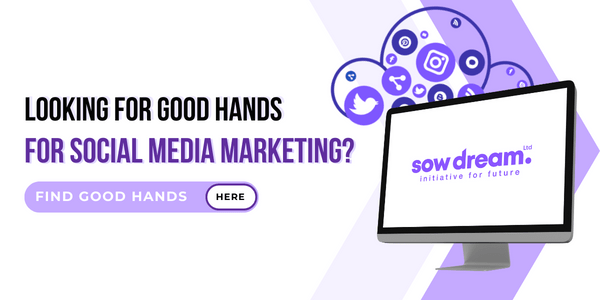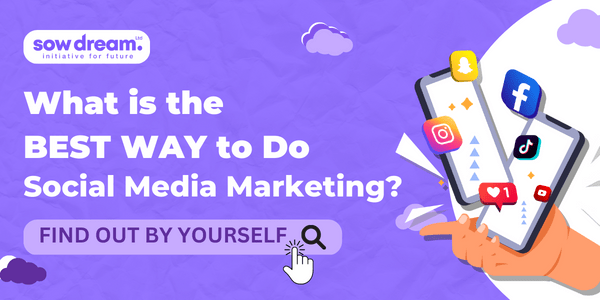9 Ninja Techniques of Social Media Marketing For New Business
When you have just kicked off your new business, and your primary target of approaching is through Social Media Marketing, then you must be aware of the common problems that an entrepreneur or a business firm faces.
Any wild guesses?
Upon our research and findings,
- Lack of a clear strategy
- Insufficient resources
- Difficulty in being Consistent
- Difficulty in determining the target audiences
- Lack of creativity and originality
- Inability to measure success
- Difficulty in keeping up with the latest trends and technology
These are the common issues that an entrepreneur or any startup goes through in general. But what could be the remedies? Well, you won’t have to worry at all because, when you dive down into this article, you will find all the solutions to these problems. Besides, we have highlighted some ninja techniques of Social Media Marketing that will surely rocket up to your expectation.
So what’s holding you?
Our Discussion
- Introduction
- The Early Days of Content Writing
- Best Social Media Platforms for Businesses
- How to Choose the Best Social Platform Based on Your Business
- 9 Ninja Techniques of Social Media Marketing
- 4 Benefits of Social Media Marketing for Businesses
- 3 Ways of Leveraging Social Media for Business Growth
- 3 Real-Life Examples of Succession for Using Social Media
- Stats on the Usage of Social Media Marketing
- 5 Social Media Marketing Strategy
- 5 Comprehensive Social Media Marketing Plan
- 7 Practical Tips on Social Media Marketing
- 3 Benefits of Social Media you can get
- How Sow Dream Works on Social Media Marketing
- The Bottom Line
Most Popular Social Media Marketing Platforms
Social media platforms are increasingly popular among people of all age groups. But each of the platforms has its own unique offerings or specialty. But before we jump into that broad section, we need to get introduced to the most popular social media platforms.
Most Popular Social Media Platforms:
- TikTok
- YouTube
- Snapchat
- Telegram
These are the most common and popular Social Media Marketing Platforms used by users. Besides all these, there are some other social media platforms as well, which are not maybe equally popular to these but are useful. For instance:
- Vimeo
- Flickr
- SoundCloud
- Quora
- Meetup
- Periscope
- Medium
- Viber
As we have mentioned earlier, each of the platforms has its own usage. Now we will categorize these platforms following their usage.
- Brand Awareness Platforms: Facebook, Instagram, Twitter, TikTok, Medium, Vimeo, SoundCloud.
- Business-to-Business (B2B) Platforms: LinkedIn, Twitter, Instagram, Medium, Quora.
- E-commerce Platforms: Instagram, Facebook, TikTok, Pinterest, Flickr.
- Recruitment Platforms: LinkedIn, Facebook, Twitter, Meetup, Quora.
- Visual-based Platforms: Instagram, Pinterest, TikTok, YouTube, Vimeo, Flickr.
- Customer Service Platforms: Facebook, Twitter, Instagram, Meetup, Viber, Weibo.
- Event and Promotions Platforms: Facebook, Instagram, TikTok, Medium, Periscope.
- News and Updates Platforms: Twitter, Facebook, LinkedIn, Medium, Quora.
These are the based categorization, and it's worth noting that these categorizations are not set in stone and can be different for different businesses.
Also, different platforms can be used for multiple purposes. It's important for businesses to research the platforms and their audience before committing to using them for their marketing efforts and to determine which platforms align with their goals and target audience.
Best Social Media Platforms for Businesses
There are many social media platforms available for businesses to use, but some are more popular and effective than others. The most popular platforms include:
- Facebook: With over 2.8 billion monthly active users, Facebook is one of the most popular social media platforms for businesses. It's a great platform for building brand awareness, generating leads and sales, and connecting with customers.
- Instagram: With over 1 billion monthly active users, Instagram is a highly visual platform that's popular among businesses that sell products or services related to fashion, beauty, travel, and food.
- Twitter: With over 330 million monthly active users, Twitter is a great platform for businesses that want to connect with their customers in real time and share news, updates, and promotions.
- LinkedIn: With over 740 million registered users, LinkedIn is a professional networking platform that's great for B2B businesses and recruiting.
- TikTok: With over 689 million monthly active users, TikTok is a new social media platform that is popular among younger audiences and businesses that want to create short-form videos and fun content.
Unique Features and Target Audiences of Each Platform
Each platform has unique features and target audiences. Facebook is a great platform for building brand awareness and connecting with a broad audience. And Instagram is highly visual, making it popular for businesses that sell products or services related to fashion, beauty, travel, and food.
On the other hand, Twitter is great for real-time communication, making it popular for businesses that want to share news, updates, and promotions.
While LinkedIn is a professional networking platform, making it popular for businesses that want to share news, updates, and promotions. It is also popular for B2B businesses and recruiting.
TikTok is popular for short-form videos and fun content, making it a great option for businesses looking to reach younger audiences.
As you know a lot about the platforms, do you know the drill for choosing the best platforms for your business based on your goals and target audience?
Here is how you can do it!
How to Choose the Best Social Platform Based on Your Business
Choosing the right social media platforms for your business can be a daunting task. Here are the drills to do so:
- Identify Business Niche: Understand what your business is all about, what products and services you are offering, and what type of audience you are trying to target. This will give you an idea of which platforms will be more suitable for your business.
- Check your Competitors: See which platforms your competitors are using and how they are using them. This will give you an idea of what works and what doesn't work in your industry.
- Test the platforms: Once you have narrowed down your options, start testing the platforms to see which one works best for your business. Try different types of content and engagement methods and see which platform generates the most results for your business.
- Use Platform-Specific Features: Each platform has its own unique features; use them to your advantage. For example, Instagram has Instagram reels, stories, and IGTV that can be used for different types of content, and LinkedIn has LinkedIn Learning, which can be used for creating educational content.
9 Ninja Techniques of Social Media Marketing
We are keeping this short because, if you dive down, you will get a detailed idea of the techniques. Combining all of them together will help you get the best possible outcome.
- Brand storytelling: Creating a compelling brand story that resonates with your target audience and sets you apart from your competitors.
- Visual Content: Creating high-quality images and videos that showcase your products and services in the best light and grab the attention of your audience.
- Data-driven Advertising: Using data and analytics to inform your advertising strategy and measure the effectiveness of your ads.
- Targeted Advertising: Using detailed audience insights to target the right people at the right time and make the most of your advertising budget.
- Customer Engagement: Building a community of loyal customers by engaging with your audience and being responsive to their needs.
- Consistency: Ensure that your brand is consistent across all social media platforms.
- Influencer Marketing: Partnering with influencers to reach a larger audience and increase brand awareness.
- Automation: Using social media automation tools to save time and streamline your social media marketing efforts.
- Continuous Optimization: Continuously testing and optimizing your social media marketing strategy to improve performance and achieve better results.
These are the 9 Ninja techniques of Social Media Marketing, and these will be the most effective techniques in 2023 as the year is predicted to be a competitive one.
4 Benefits of Social Media Marketing for Businesses
Social media marketing has become an essential part of any business's marketing strategy. It offers a wide range of benefits that can help businesses of all sizes and industries to increase brand awareness, drive website traffic, generate leads and sales, and ultimately, grow their bottom line.
Some of the most notable benefits of social media marketing include:
- Increased Brand Awareness: Social media platforms provide businesses with the opportunity to reach a large and diverse audience, which can help to increase brand awareness and visibility.
- Improved Customer Engagement: Social media allows businesses to interact with their customers in real-time, which can help to build trust and loyalty.
- Increased Website Traffic: Social media can drive significant traffic to a business's website, which can, in turn, lead to increased sales and revenue.
- Greater Insights into Customer Behavior: Social media platforms provide businesses with valuable insights into their customers' behavior, preferences, and demographics, which can help to inform marketing and product development strategies.
3 Ways of Leveraging Social Media for Business Growth
Social media has become an essential tool for businesses looking to increase their brand awareness, drive traffic, and generate leads and sales.
As the number of social media users continues to grow, the opportunities for businesses to connect with their target audience and grow their customer base are endless. Here we will discuss how to increase brand awareness, drive traffic and generate leads and sales.
-
Increasing Brand Awareness: Building Visibility and Trust
In today's digital landscape, social media has become a crucial platform for businesses to establish strong and recognizable brands. By creating a consistent visual identity and sharing relevant and valuable content, businesses can increase their visibility and reach on social media platforms.
Through regular engagement with followers and potential customers, businesses can also build trust and establish themselves as a reliable and trustworthy source of information within their industry.
One effective strategy for increasing brand awareness on social media is to focus on creating high-quality, visually-appealing content that reflects the values and message of your brand.
By consistently posting content that aligns with your brand identity, you can help establish a strong and recognizable presence on social media. Additionally, by actively engaging with your followers and responding to their comments and messages, you can demonstrate your commitment to providing excellent customer service and building relationships with your audience.
Another effective strategy for increasing brand awareness is to leverage the power of influencer marketing. By partnering with influencers in your industry, you can tap into their established audience and reach a wider audience with your brand message. This can be especially effective if the influencer aligns with your brand's values and message.
By consistently implementing these strategies, businesses can effectively increase their brand awareness and establish themselves as trusted and recognized brands in their industry.
- Driving Traffic: Directing Followers to Your Website
One of the key benefits of social media marketing is the ability to drive traffic to your website. By including links to your website in your social media posts, you can direct your followers to your website, where they can learn more about your business and potentially make a purchase.
An effective strategy for driving traffic to your website is to create compelling and valuable content that entices your followers to click through to your website. This can include blog posts, infographics, videos, or other types of content that provide valuable information or insights related to your business or industry.
Another strategy for driving traffic to your website is to run social media ads that target your desired audience.
Platforms like Facebook and Instagram allow businesses to create ads that are targeted to specific demographics and interests, which can help increase the chances of your ad being seen by potential customers.
To increase the chances of your followers clicking through to your website, it's also important to optimize your website for mobile devices and ensure that it loads quickly. This will improve the user experience and encourage your followers to stay on your website longer and explore more of your content.
By effectively utilizing these strategies, businesses can increase their website traffic and generate more leads and sales from their social media efforts.
- Generating Leads and Sales: Understanding Your Target Audience and Meeting Their Needs
Social media platforms offer businesses valuable insights into their customers' behavior, preferences, and demographics. By analyzing social media data, businesses can gain a better understanding of their target audience and use this information to inform their marketing and product development strategies.
One effective strategy for generating leads and sales through social media is to use social media listening tools to monitor and track the conversations and feedback of your target audience.
This can help you identify the most pressing concerns and needs of your target audience and tailor your content and products to better meet those needs.
Another strategy is to use social media advertising to target specific demographics and interests. Platforms like Facebook and Instagram allow businesses to create ads that are targeted to specific demographics and interests, which can help increase the chances of your ad being seen by potential customers.
Additionally, businesses can use social media platforms to run promotions, discounts, and other types of offers, which can entice potential customers to make a purchase.
By understanding and meeting the needs of your target audience, businesses can effectively generate leads and sales from their social media efforts.
3 Real-Life Examples of Succession for Using Social Media
There are countless examples of businesses of all sizes and industries that have seen success through social media marketing. Here are a few notable examples:
- Starbucks: The coffee giant has built a massive following on social media by sharing engaging content that highlights its products, values, and community involvement. This has helped to increase brand awareness and drive sales.
- HubSpot: This inbound marketing software company has used social media to build a strong brand identity and increase its visibility among potential customers. Its social media strategy has helped it generate leads and drive website traffic.
- Burberry: The luxury fashion brand has used social media to connect with customers and create a sense of community around its brand. This has helped to increase brand awareness and drive sales. Besides that, they brought interactive experiences for their customers. For example, they have used Instagram and Snapchat to create virtual try-on experiences, allowing customers to virtually try on products before making a purchase. This helped to increase customer engagement and drive sales.
These are just a few examples of how businesses have used social media marketing to drive success. By creating and sharing relevant and engaging content, interacting with customers, and using social media data to inform their strategies, businesses of all sizes and industries can see similar results.
Stats on the Usage of Social Media Marketing
The use of social media has become deeply embedded in our everyday routines, and it is no surprise that it has also become a crucial part of business marketing strategies.
According to recent statistics, there are over 4.7 billion active Internet users worldwide, and over 3.8 billion of them are active on social media. Additionally, social media usage continues to grow, with an estimated 4.41 billion people projected to use social media by 2025.
In terms of specific platforms, Facebook remains the most popular social media platform, with over 2.8 billion monthly active users, followed by YouTube, with over 2 billion monthly active users, and WhatsApp, with over 2 billion monthly active users.
Furthermore, social media has a significant impact on businesses as well. A study by Sprout Social found that 72% of consumers who had a positive social media experience with a brand were likely to recommend it to others.
Additionally, a survey by Hootsuite and We Are Social found that social media has a direct impact on purchasing decisions, with 30% of respondents saying that social media has influenced their purchasing decisions in the past month.
These statistics clearly demonstrate the importance of having a strong social media presence for businesses.
With such a large portion of the world's population active on social media, businesses that are not present on these platforms are missing out on a significant opportunity to reach and engage with their target audience.
Additionally, the statistics on the impact of social media on purchasing decisions highlight the importance of building a positive social media reputation. Businesses that can create a positive experience for customers on social media are more likely to see an increase in sales and revenue.
How Businesses Can Use These Statistics for Social Media Marketing
Businesses can use these statistics to inform their social media marketing strategy in several ways. Firstly, by understanding the popularity of specific platforms, businesses can make informed decisions about which platforms to focus their efforts on.
Secondly, businesses can use statistics on the impact of social media on purchasing decisions to prioritize building a positive social media reputation.
This can be achieved by creating and sharing relevant and engaging content, interacting with customers, and responding to feedback in a timely manner.
Finally, businesses can use the statistics on the projected growth of social media usage to plan for the future. By understanding that social media usage is projected to continue growing, businesses can make sure that they are well-positioned to take advantage of the opportunities that this growth will bring.
Overall, these statistics highlight the importance of having a strong social media presence and the potential impact it can have on a business. By understanding and utilizing these statistics, businesses can create effective social media marketing strategies that drive success.
5 Social Media Marketing Strategy
A well-crafted social media marketing strategy can help businesses in multiple ways. It can increase brand awareness by reaching a larger audience and improve customer engagement by building trust and loyalty.
Let’s sneak peek at the Key Elements of a Successful Social Media Marketing Strategy.
Key Elements of a Successful Social Media Marketing Strategy
- Setting Clear and Measurable Goals: The first step in creating a successful social media marketing strategy is to set clear and measurable goals. These goals should align with your overall business objectives and be specific, actionable, and time-bound.
- Identifying your Target Audience: Understanding who your target audience is and what they are looking for on social media is crucial to creating a successful strategy. By understanding your target audience, you can create content that resonates with them and engage with them in a meaningful way.
- Choosing the Right Platforms: Not all social media platforms are created equal. Different platforms have different audiences and features, so it's important to choose the platforms that are most likely to reach your target audience.
- Creating a Content Calendar: A content calendar is a crucial tool for organizing and planning your social media content. It helps you to plan ahead and ensure that you have a steady flow of relevant and engaging content to share with your audience.
- Measuring and Analyzing Performance: The final step in creating a successful social media marketing strategy is to measure and analyze performance. This allows you to understand what's working and what isn't and make adjustments as needed to improve your results.
Expert Tips on How to Create a Strategy
Here are some more tips on how to create a social media marketing strategy that is tailored to your business's goals and target audience:
- Research your Target Audience: Gather data on your target audience, including demographics, interests, and behaviors. Use this information to create buyer personas and understand what type of content and messaging will resonate with them.
- Set Realistic and Specific Goals: Be specific and realistic with your goals. For example, instead of aiming for more followers, aim for a certain percentage increase in engagement or website traffic.
- Choose the Right Platforms: Research the different social media platforms to find out which ones your target audience is most active on. This will help you to focus your efforts on the platforms that will have the most impact.
- Create a Content Calendar: Use a content calendar to plan and schedule your social media content in advance. This will help you to ensure that you have a steady flow of relevant and engaging content to share with your audience.
Measure and analyze performance: Use analytics tools to track your progress and measure the success of your social media marketing strategy. This will help you to understand what's working and what isn't and make adjustments as needed.
But how do you know your social media marketing strategy is actually succeeding?
Well, here is how!
Measure the Success of Your Social Media Marketing Strategy
Measuring the success of your social media marketing strategy is crucial to understanding what's working and what isn't. Here are a few key metrics that you should track to measure the success of your strategy:
- Engagement: Track engagement metrics such as likes, shares, comments, and click-throughs to understand how well your content is resonating with your audience.
- Followers: Track the number of followers you have on each platform to understand how well you are growing your audience.
- Website Traffic: Use analytics tools to track the amount of traffic that is being driven to your website from social media.
- Conversion Rate: Track the number of leads or sales generated from social media to understand the ROI of your social media marketing efforts.
By tracking these metrics, you can gain a better understanding of what's working and what isn't and make any changes to the strategies, if required.
5 Comprehensive Social Media Marketing Plan
Creating a comprehensive social media marketing plan is essential for businesses of all sizes and industries. Here are the key steps for developing a plan that will drive success:
- Define your Social Media Marketing Goals: Before you start creating your plan, you need to define your goals. These goals should be specific, measurable, and aligned with your overall business objectives.
- Conduct a Social Media Audit: Conducting a social media audit is an important step in creating a social media marketing plan. This will help you to identify the strengths and weaknesses of your current social media presence and identify opportunities for improvement.
- Identify your Target Audience: Understanding who your target audience is and what they are looking for on social media is crucial to creating a successful plan. Use this information to create buyer personas and understand what type of content and messaging will resonate with them.
- Develop a Content Strategy: A content strategy is an essential part of a social media marketing plan. It should include the type of content you will create, the frequency of your posts and the platforms you will use to share your content.
- Create a Social Media Calendar: Once you have developed your content strategy, you can create a social media calendar to schedule your posts in advance. This will help you to ensure that you have a steady flow of relevant and engaging content to share with your audience.
3 Ways to Set Measurable Goals for Your Plan
Here are some tips on how to set measurable goals and objectives for your social media marketing plan:
- Break down your overall goals into smaller, more manageable goals. This will make it easier to measure your progress and adjust your plan as needed.
- Use metrics that are relevant to your goals. Choose metrics that align with your goals, such as engagement rate or website traffic from social media.
- Set a deadline for your goals. Give yourself a deadline for each goal so that you can measure your progress and make adjustments as needed.
Ways to Allocate Resources for Your Social Media Marketing Efforts
Allocating resources effectively is crucial for the success of your social media marketing plan. Firstly, identify the resources you will need. Identify the resources you will need to execute your plan, including a budget, personnel, and tools.
Secondly, prioritize your needs. Prioritize your needs based on their importance to achieving your goals. Thirdly, use automation tools that can help you to save time and resources by automating repetitive tasks such as scheduling and analytics tracking.
And finally, monitor your progress and make adjustments as needed. Be sure to reassess and adjust your resource allocation as needed to ensure that you are getting the best return on investment.
Overall, creating a comprehensive social media marketing plan requires defining your goals, conducting a social media audit, identifying your target audience, developing a content strategy, and creating a social media calendar.
Additionally, it is important to set measurable goals and objectives and allocate resources effectively. By following these steps, businesses can create a plan that drives success and achieves their desired outcome.
Now that you have gone through all these metrics and statistics, now let’s dive into some social media marketing tips which will keep you ahead around all.
7 Practical Tips on Social Media Marketing
When it comes to social media marketing, there are a few key things to keep in mind to ensure that your efforts are as effective as possible. Consistency is crucial, so make sure that you are posting regularly and keeping your content fresh and relevant.
Using visual content like images and videos can also be a great way to grab your audience's attention and increase engagement.
Utilizing hashtags is also important as it can help to increase the visibility of your content and make it easier for people to find and engage with your brand.
Responding to comments and messages is an important part of social media marketing. It shows that you are engaged with your audience and willing to listen to their feedback. And finally, using analytics tools to track your progress and measure the success of your social media marketing efforts can be extremely helpful in understanding what's working and what isn't and making adjustments as needed.
How to Create and Curate Engaging Content
Creating and curating engaging content is crucial for the success of your social media marketing efforts. Here are a few tips on how to do so:
- Know your Audience: Understand who your target audience is and what they are looking for on social media. Use this information to create content that resonates with them and meets their needs.
- Use a mix of Content Types: Use a mix of content types, including text, images, videos, and infographics, to keep your audience engaged and interested.
- Keep it Fresh: Keep your content fresh and relevant by regularly creating and sharing new content.
- Share User-Generated Content: Share user-generated content, such as customer reviews and testimonials, to build trust and credibility with your audience.
Engaging with Your Audience and Building a Community
Engaging with your audience and building a community is crucial for the success of your social media marketing efforts. At first, encourage engagement by asking questions, running polls, and hosting giveaways. Secondly, respond to comments and messages timely and maintain a professional manner.
And to build up a community, create a sense of community at first by hosting events, such as Twitter chats or Instagram live sessions.
And some QUICK TIPS for you
- Show your Personality: Show your personality and let your audience get to know the people behind your brand.
- Show Appreciation: Show appreciation for your audience by recognizing and responding to their contributions.
By following these tips and insights, businesses can create a social media marketing strategy that effectively engages with the audience and build a strong community of loyal followers.
Are you wondering how building a strong community of loyal followers can help you in growth? Well, it may not directly send you the aid that you are looking for, but practically it can increase the ratio of communication. And the benefit of communication is very broad indeed.
But don’t you worry! You have got yourself covered as well.
3 Benefits of Social Media You Can Get
In today's digital age, social media has become a robust tool for businesses and individuals alike. Whether you're looking to connect with friends and family, promote your brand, or grow your business, social media has something to offer. From boosting communication to increasing ROI, these benefits are sure to help you make the most of your social media efforts. So, let's see how social media can actually become beneficial for us!
Benefits of Social Media for Communication
Social media has revolutionized the way we communicate with one another. It has opened up new opportunities for businesses to connect with their customers, employees, and partners. Here are a few benefits of using social media for communication:
- Increased Reach: Social media platforms have billions of users worldwide, which means businesses have the opportunity to reach a much larger audience than they would be able to through traditional means.
- Real-time Communication: Social media allows for real-time communication, which is particularly beneficial for businesses that need to respond quickly to customer inquiries or for crisis management.
- Cost-Effective: Social media is a relatively low-cost way for businesses to communicate with their audience. It can be used to reach a large audience without the need for expensive advertising campaigns.
- Personalization: Social media allows businesses to personalize their communication with their audience. They can use different platforms to target specific demographics and tailor their messaging to different groups.
- Increased Engagement: Social media can help businesses increase engagement with their audience by allowing them to communicate in a more conversational way. They can use social media to build relationships with their audience and create a community of loyal customers.
- Increased Brand Awareness: The more you engage with your target audience, the more you build trust and brand awareness. Social media is a great way to increase brand awareness by creating a consistent brand message and by engaging with the audience.
- Increased Customer Loyalty: Social media can help businesses create loyal customers by providing them with a platform to communicate with the business, ask questions, and provide feedback. By responding to customer queries and complaints in a timely manner, businesses can show that they value their customers and are dedicated to providing them with a positive experience.
Overall, social media has become an essential tool for businesses to communicate with their audience. It allows them to reach a larger audience, engage with them in real time, and personalize their messaging, all while keeping costs low.
By utilizing social media effectively, businesses can build stronger relationships with their audience and increase their brand awareness and customer loyalty.
Benefits of Social Media for Advertising
Social media advertising has become an essential part of any business's marketing strategy. It offers a range of benefits that traditional advertising methods just can't match. Here are a few benefits of using social media for advertising:
- Cost-Effective: Advertising on social media is relatively low-cost as compared to traditional forms of advertising such as TV, radio, and print. This makes it an ideal choice for small businesses with limited budgets.
- High Engagement: Social media platforms offer high engagement and interaction with the audience. Businesses can use this to build a relationship with their target audience and get valuable feedback on their products and services.
- Audience Targeting: Social media platforms offer sophisticated targeting options, which allow businesses to reach their ideal audience. This ensures that the advertising budget is used effectively and reaches the right people.
- Measurable Results: Social media advertising provides measurable results in real-time, which allows businesses to track their ROI and make adjustments as needed.
- Greater Flexibility: Social media advertising allows businesses to test different strategies, ad creatives, and targeting options. This allows them to find the most effective approach for their business and audience.
- Increased Website Traffic: Social media advertising can drive website traffic and increase conversions by directing the audience to the business website. This can lead to increased sales, lead generation, and customer acquisition.
Social media advertising offers a cost-effective, measurable, and highly targeted approach to reaching the right audience. It allows businesses to build brand awareness, increase website traffic and drive conversions. By utilizing social media effectively, businesses can achieve their advertising objectives and reach their target audience in a more personalized and engaging way.
Benefits of Social Media for Proving ROI
Measuring the return on investment (ROI) of social media marketing can be challenging, but it is essential for businesses to understand the impact of their social media efforts. Here are a few benefits of using social media for proving ROI:
- Detailed Analytics: Social media platforms provide detailed analytics and insights, which allow businesses to track key metrics such as engagement, reach, and conversions. This makes it easy to measure the effectiveness of their social media marketing efforts and track the ROI.
- Easy to Track Conversions: Social media platforms like Facebook and Instagram have built-in conversion tracking tools, which allow businesses to track the number of conversions that occurred as a result of their social media advertising.
- Low-cost Marketing: Social media is a low-cost marketing channel, which makes it an ideal option for small businesses or those with limited budgets. It allows businesses to reach a wider audience and generate leads at a fraction of the cost of traditional marketing methods.
- Better Customer Understanding: Social media platforms provide detailed audience insights which allow businesses to understand their customers better. This can be used to inform product development and service offerings and increase customer satisfaction.
Social media can provide significant benefits to businesses in terms of proving ROI. Detailed analytics, conversion tracking tools, and increased transparency make it easy for businesses to track the effectiveness of their social media marketing efforts and measure the ROI. By utilizing social media effectively, businesses can increase customer engagement and brand awareness and generate leads at a low cost.
How Sow Dream Works on Social Media Marketing
At Sow Dream, we understand that every business is unique, and so are its social media marketing needs. That's why we take an out-of-the-box approach to social media marketing. Our team of experts starts by getting to know your business and its goals, and then we develop a custom strategy that is tailored to your specific needs.
One of the unique things we do is that we focus on creating a strong brand story for your business. We believe that your brand story is what sets you apart from your competitors, and it's what will make you stand out on social media. Our team of creative writers and designers works together to craft a compelling brand story that will resonate with your target audience.
We also focus on creating visually stunning content that will grab the attention of your audience. We create high-quality images and videos that showcase your products and services in the best light. We know that visual content is more likely to be shared and get engagement on social media, so we make sure that every piece of content we create is visually appealing.
Another thing that sets us apart is our approach to social media advertising. We don't just run ads and hope for the best. We use data and analytics to inform our advertising strategy. We use tools like Facebook and Instagram's conversion tracking to measure the effectiveness of our advertising and make adjustments as needed. We also use detailed audience insights to target the right people at the right time.
We also understand the importance of customer engagement on social media. We make sure that our clients are responsive to their audience and that they are building a community of loyal customers. We also make sure that the brand is consistent across all social media platforms.
At Sow Dream, we take a holistic approach to social media marketing. We understand that it's not just about creating content and running ads. It's about building a brand, engaging with your audience, and generating leads. We work closely with our clients to understand their unique needs and develop a strategy that will help them achieve their goals. Here are some recent works of ours. We want you to check it out before you collaborate with us.
The Bottom Line
In conclusion, social media marketing is a crucial component of any business's marketing strategy. With the right approach, businesses can leverage the power of social media to reach new audiences, build brand awareness, and drive conversions. The 9 Ninja Techniques outlined in this blog, from creating a strong brand story to using data-driven advertising and influencer marketing, can help businesses achieve their goals and stand out in a crowded digital landscape.
At Sow Dream, we pride ourselves on taking an out-of-the-box approach to social media marketing, helping businesses to uncover new opportunities and maximize their ROI.
By understanding the specific needs and goals of each business, we work together to create a comprehensive social media marketing plan that is tailored to their requirements. Remember, social media marketing is a continuous process, so always be ready to adapt and optimize your strategy to stay ahead of the competition.







.png)
.png)
.png)



